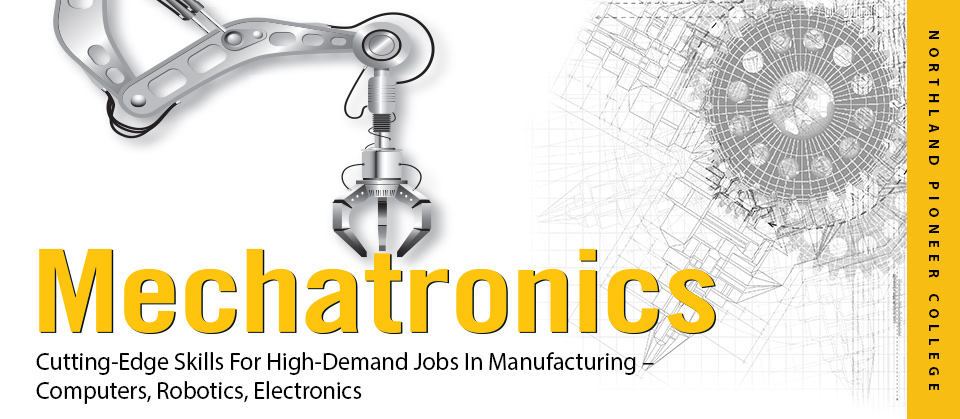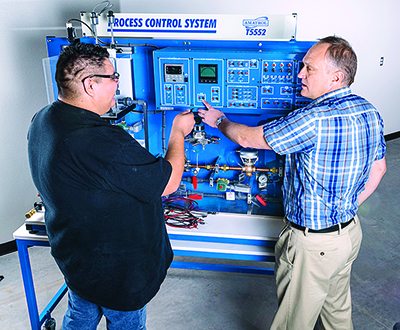Cutting-Edge Skills For High-Demand Jobs In Manufacturing – Computers, Robotics, Electronics
When Henry Ford implemented assembly line techniques to automobile production in 1913, he revolutionized the skills needed in manufacturing. Factories became filled with low- or semi-skilled workers, who performed repetitive tasks for low pay, often in dirty, dark and noisy conditions. Yesterday’s factories have evolved into automated, advanced manufacturing, where workers with a high level of technical skills are needed to run and maintain complex machines, robots and computer systems.
These new technology-based jobs require specific training in mechanics, electrical circuitry and technology. To help train workers for these careers of the future, Northland Pioneer College combined these studies into a new Mechatronics program, based at the Skills Center on the Holbrook campus.
With experience in power plant operations, electrical systems, instrumentation and programmable logic controllers and a Bachelor of Science degree in Manufacturing Engineering from Brigham Young University, Charlie Perkins, instructor of Mechatronics at NPC, feels his experience works well to teach Mechatronics, “which integrates multiple disciplines into a single program of study.”
“The dirty, dangerous, labor intensive environment of American manufacturing is being replaced by clean, safe, automated production systems,” says Perkins. “The demand and opportunities for people who have skills [in Mechatronics] is high now and will continue to grow in the future.”
The U.S. Department of Labor reports Advanced Manufacturing occupations grew by 99.4 percent between 2007 and 2012, and the demand for workers is expected to continue. Economic Modeling Specialists International projects the American manufacturing sector will add 2.5 million new jobs by 2017.
However, because the public’s perception is that manufacturing is still a dirty, dark and dangerous career, employers are finding a “skills gap,” with too few technical workers. “Eighty percent of manufacturers report they cannot find individuals with the skills required,” notes AJ Jorgenson of the Manufacturing Institute. “Today’s manufacturing is about advanced technologies, state-of-the-art facilities, and fast-paced work environments,” states Jorgenson. Manufacturing medical devices is “lab coat work.”
To meet this new demand for trained employees, the NPC Mechatronics program educates students to become “electro-mechanical technicians,” who will be able to install, repair, upgrade and test computer-controlled mechanical systems, often dealing with robotic machinery. In Arizona, the mean annual salary for an “electro-mechanical technician” is $52,850 (BLS, May 2013).
Students who take advantage of NPC’s new Skills Center in Holbrook are able to receive hands-on training and work with the same equipment found in the manufacturing and industrial fields. The goal is to provide an ideal learning environment for mastering the fundamentals required for Mechatronics.
To obtain an Associate of Applied Science (AAS) degree in Mechatronics a student must complete 66 credits, which includes certification as an A+ Computer Technician and courses in industrial mechanics, electrical systems, logic controllers, robotics and electrical machines. Students also complete a hands-on application project. Overall program emphasis is on predictive maintenance, troubleshooting and quality assurance.
Because this program can be hard to find in the United States, let alone Arizona, Perkins urges students to look into the field of Mechatronics and see what exciting possibilities lie ahead. He also invites those who are interested in the program to visit the NPC Skills Center in Holbrook to see the latest equipment available for student use.
Myth: Manufacturing in the U.S. is dead.
Against an economic backdrop of the “rise of China,” it’s easy to forget that the U.S. continues to be far and away the largest overall producer of goods and services in the world. If the U.S. manufacturing sector were its own country, it would still rank as the eighth largest economy in the world – producing more than the entire gross domestic product of India, a well-known export giant!
U.S. manufacturing production is expected to rise 3.5 percent in 2015, and 4 percent in 2016, according to the MAPI Foundation.
– Michael Nilsson with contributions from Naomi Sheehan



